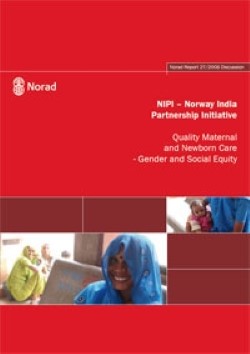NIPI – Norway India Partnership Initiative
Om publikasjonen
- Utgitt: januar 2010
- Serie: Norads rapportserie
- Type: Norad-rapport
- Utført av: Bodil Maal, NORAD, Oslo, Renu Wadehra, Embassy of Norway, New Dehli
- Bestilt av: --
- Land: India
- Tema: Helse, Kvinner og likestilling, Barn
- Antall sider: 40
- Serienummer: 28/2009
- ISBN: 978-82-7548-449-7
- ISSN: --

NB! Publikasjonen er KUN tilgjengelig elektronisk og kan ikke bestilles på papir
Executive summary
- The Norway - India Partnership Initiative (NIPI) works within the National Rural Health Mission (NRHM) of India. NRHM aims to provide effective health care to the rural population, especially tribal groups including women and children, by improving access, enabling ownership and demand for services. NIPI focuses on reducing child and maternal mortality in five of the 18 states of NRHM in order to assist India in reaching the MDG 4 goal by 2015.
- The criteria used for the selection of districts in the five NIPI states is not clear and noone seems to have an answer to why the actual district were chosen. The districts should have been representative for the geographical and socio-economic condition in the state.
- The NIPI secretariats in the five states employ nine men and one woman. In a programme working on MDG 4 and MDG 5 there is a need to recruit more women into decisionmaking positions in NIPI.
- Maternal fatalities are highest among illiterate women from SC and ST.1 Studies show that child mortality is also highest in these groups. The caste system is still functioning in many villages in rural areas of the five NIPI states. Women, and especially women from SC and ST, have low status in India. Men have control over their productive labour, reproduction, mobility and economic resources. This control is the key to the suppression of women and their poor health. Gender mainstreaming in NIPI has to take into consideration both the caste system and the patriarchal family structure
- The team found several shortcomings in the “ASHA chain” from village to hospital. ASHAs are not recruited from SC and ST due to educational requirements. The quality of ASHA training is questioned. Coordination between different actors in the villages working on health issues is also a concern. There is very little emphasis on homebased care of the mother and child in the programme.
- Incentive systems where ASHAs, yashodas and pregnant woman are paid create much corruption and conflict. ASHAs from SC/ST are not aware of their rights and have to pay up to 50% of the money they receive in bribes to hospital staff. This has to be looked into by NIPI.
- Hospital infrastructure investment at hospitals has to prioritise beds, sheets, sanitation and generators. Supply of food to patients, visitor accommodation and hygiene improvements have to be looked into. Investing in LCD screens should not be prioritised.
- Most doctors employed in public hospitals run private clinics. This is alleged to impact on investments in public hospitals. The health managers must be empowered to do their jobs.
Publisert 02.02.2010
Sist oppdatert 16.02.2015
